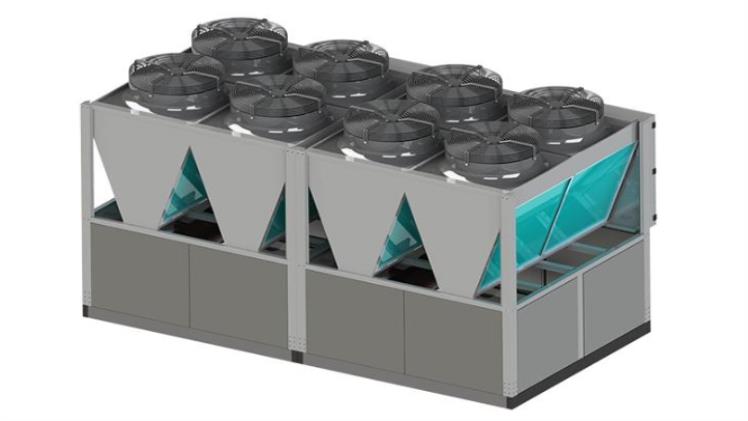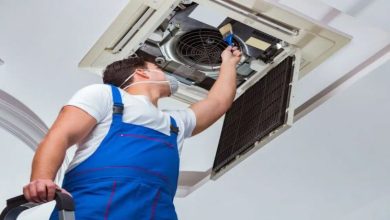
Selecting the right air conditioning system is one of the most important technical and economic decisions in building design and industrial projects. Cooling Systems not only provide comfortable indoor temperatures for occupants but also directly affect energy consumption, maintenance costs, and equipment lifespan. In hot-arid and semi-arid regions such as Baghdad, Basra, Muscat, Ahvaz, and Sulaymaniyah, extreme summer temperatures significantly increase energy demand and strain the electrical grid. Therefore, choosing an energy-efficient cooling system is crucial not only for maintaining comfort but also for reducing energy and operational costs. This article examines one of the most energy-efficient cooling systems commonly used in hot climates, as well as key considerations for selecting it.
Importance of Choosing an Efficient Cooling System
Cooling systems should be selected based on project requirements, climatic conditions, building type, and cooling load to maximize efficiency while minimizing cost. Choosing the right system in hot regions requires a thorough technical assessment and matching the system capacity to the building and environmental conditions. Given the wide range of products available, consulting experienced experts is essential to identify the optimal solution.
To save energy and reduce electricity consumption in any HVAC equipment, the following should be considered:
- Selecting a system with a capacity suited to the building’s cooling load
- Using systems with load control and modulation features
- Installing equipment in locations that allow proper airflow and natural ventilation
- Performing regular maintenance to prevent efficiency losses
Hence, knowing which type of air conditioning appliance works the best in your region with the lowest energy consumption is vital.
Guide to Selecting Optimal Cooling Equipment for Hot-Arid Climates
In hot climates, choosing an appropriate cooling system is critical. It leads to achieving maximum efficiency with minimal cost and electricity usage. First, calculate the building’s cooling load based on the area, number of floors, and occupants. Then select the system type suited to the project. Attention should also be given to energy efficiency, electricity consumption, ease of service and maintenance, as well as the lifespan of ancillary components. These factors significantly affect long-term costs.
This article focuses on one of the most widely used systems in hot-arid regions: the air-cooled chiller.
Air-Cooled Chillers: Energy-Efficient for Hot-Arid Regions
Chillers are considered the core of industrial and commercial cooling systems. Air-cooled chillers operate on a vapor-compression cycle, consisting of four main components: the compressor, evaporator, condenser, and expansion valve. To determine whether an air cooled chiller is energy-efficient and suitable for hot, arid climates, it is essential to understand its operation and types.
Air-Cooled Chillers Main Components
Air-cooled chillers use a vapor-compression cycle to cool the building’s circulating water. Their main components include:
- Compressor: Compresses refrigerant gas, raising its pressure and temperature for condensation
- Evaporator: Transfers heat from circulating water to the refrigerant, creating cooling
- Condenser: Rejects heat from the refrigerant to the environment
- Expansion Valve: Reduces refrigerant pressure, preparing it for the next cycle
Types of Air-Cooled Chiller Compressors and Features
The compressor is the most critical component of an air chiller. In other words, chillers are generally classified based on the compressor type: reciprocating, screw, centrifugal, and scroll. Compressors either mechanically compress refrigerant (positive displacement) or use kinetic energy to increase pressure (dynamic).
Positive Displacement Compressors
These compress a fixed volume of refrigerant per cycle and include reciprocating, screw, and scroll types:
- Reciprocating: Suitable for 5–150 TR, available in hermetic, semi-hermetic, or open designs
- Screw: Single or twin rotor, 80–750 TR, higher efficiency and lower vibration
- Scroll: Up to ~30 TR, low noise, ideal for small buildings and apartments
Air-Cooled Reciprocating Chillers
Air cooled reciprocating chillers use piston motion to compress refrigerant. They are economical for small to medium projects; multiple compressors can be used for larger loads. The advantages of reciprocating air-cooled chillers include easy control and adjustable speed. After all, their drawbacks are higher energy consumption, maintenance, noise, and vibration. Their capacity is typically up to 200 TR (BTU/hr).
Air-Cooled Screw Chillers
The screw air cooled chillers utilize rotary screw compressors (single or twin). They provide high compression ratios, fewer moving parts, lower energy usage, less noise, and longer lifespan. Air cooled screw chillers are suitable for medium to large projects up to ~750 TR. Please note that their initial cost is higher than reciprocating air chillers.
Air-Cooled Scroll Chillers
Air-cooled scroll chillers use scroll compressors to compress refrigerant through two spiral disks. The scroll type of air cooled chillers is small in size, low noise, and has minimal vibration. This model is ideal for buildings up to ~30 BTU/hr. Limited serviceability and potential oil loss at low temperatures are disadvantages.
Dynamic Compressors
Centrifugal compressors use kinetic energy to raise refrigerant pressure, suitable for high capacities:
- Centrifugal: 90–1000 TR, high efficiency at full load, ideal for large industrial spaces
Air-Cooled Centrifugal Chillers
Ventrifugal air-cooled chillers employ centrifugal dynamic compressors to compress large refrigerant volumes at relatively low pressure. High efficiency at full load, low energy consumption, and suitability for 150–1000 TR, especially for large projects, are the boldest features of this model. Drawbacks of centrifugal chillers are poor partial-load performance, surge risk, and high cost under 200 TR.
Why Compressor Selection for Air Cooled Chillers Matters?
The compressor is the core of any air chiller and directly affects capacity, efficiency, and operating costs. Selecting the appropriate type is crucial for optimal performance in central cooling systems.
Comparison of Air-Cooled Chillers: Capacity and Lifespan
To compare air cooled chillers in terms of capacity, you should know that:
- Reciprocating: 5–150 TR, 0.7–1.3 kW/TR
- Screw: 80–750 TR, 0.65–1.5 kW/TR
- Centrifugal: 90–1000 TR, 0.5–0.7 kW/TR
And for comparing air-cooled chillers in terms of lifespan, you should consider:
- Reciprocating: ~20 years
- Screw & Centrifugal: ~30 years
Selecting an Air-Cooled Chiller by Size
Here is a brief review of what you’ve learned so far about selecting an air cooled chiller according to your project’s dimensions:
- Small units (up to 150 TR): The Reciprocating chiller is economical
- Medium to large units (150–750 TR): Screw chiller is optimal
- Enormous units (>750 TR): Centrifugal chiller for high efficiency and stability
- Mini apartments (less than 30 TR): Scroll chiller for low noise and compact design
Generally, for large buildings, an air-cooled chiller is preferable, while for smaller units, split systems or air washers perform better. By keeping this structure in mind, you can effortlessly select the best option that fits your project. Moreover, if you have any further questions, you can consult with DamaTajhiz’s expert specialists.
Purchasing Cooling Equipment from Trusted Manufacturers
In recent years, the demand for advanced and efficient cooling systems has grown significantly. Selecting the right system ensures indoor air quality, reduces energy consumption and maintenance costs, as well as extends equipment lifespan. Of course, purchasing such a costly system should be done from trusted manufacturers and suppliers. Engineers and project owners can confidently pick up the best products at competitive prices with expert advice from DamaTajhiz, a trusted supplier of HVAC and building equipment since 2004. Their experienced team analyzes cooling loads and project conditions to recommend optimal solutions, maximizing system performance and efficiency. This team is headed by engineer Majid Zavvarian, who has more than 30 years of experience in building facilities and HVAC systems.
HVAC engineers at DamaTajhiz Group are constantly working to enhance their expertise and share their knowledge with the public. For this reason, our team publishes scientific articles every day covering various HVAC topics. For example, in the article “Pros and Cons of All Air Conditioning Systems” of Damatajhiz.com/ar, you can find a comprehensive explanation of the features and limitations of different air conditioning devices such as fan coil units, split air conditioners, ducted AC systems, air handling units, types of compression chillers, VRF/VRV systems, mini chillers, industrial evaporative air coolers, air washers, cooling towers, and more.
damatajhiz.com/en/mag/cooling-and-ventilation-equipment/advantages-and-disadvantages-of-air-conditioning-systems
You can purchase a wide range of HVAC and MEP products—including air washers, cooling towers, chillers, air handling units, industrial evaporative coolers, air curtains, burners, cast-iron or steel boilers, heat exchangers, gas heaters, unit heaters, circulation pumps, sand filters, and water or fuel storage tanks—from countries such as the UAE, Armenia, Tajikistan, Georgia, Azerbaijan, Turkey, Oman, Pakistan, Turkmenistan, Afghanistan, Kuwait, Bahrain, Qatar, and Iraq, covering regions across Asia, the Middle East, and Europe. Deliveries are available to cities including Manama, Baghdad, Karachi, Dubai, Sharjah, Muscat, Abu Dhabi, Kuwait City, Jeddah, Sana’a, Doha, Amman, Sulaimaniyah, Sofia, Kirkuk, Islamabad, Mosul, Erbil, Dushanbe, Aleppo, Damascus, Baku, and Kabul. Additionally, you can get free professional consultation on any HVAC-related questions by calling +98-930-288-0251 or sending a WhatsApp message to the same number.





